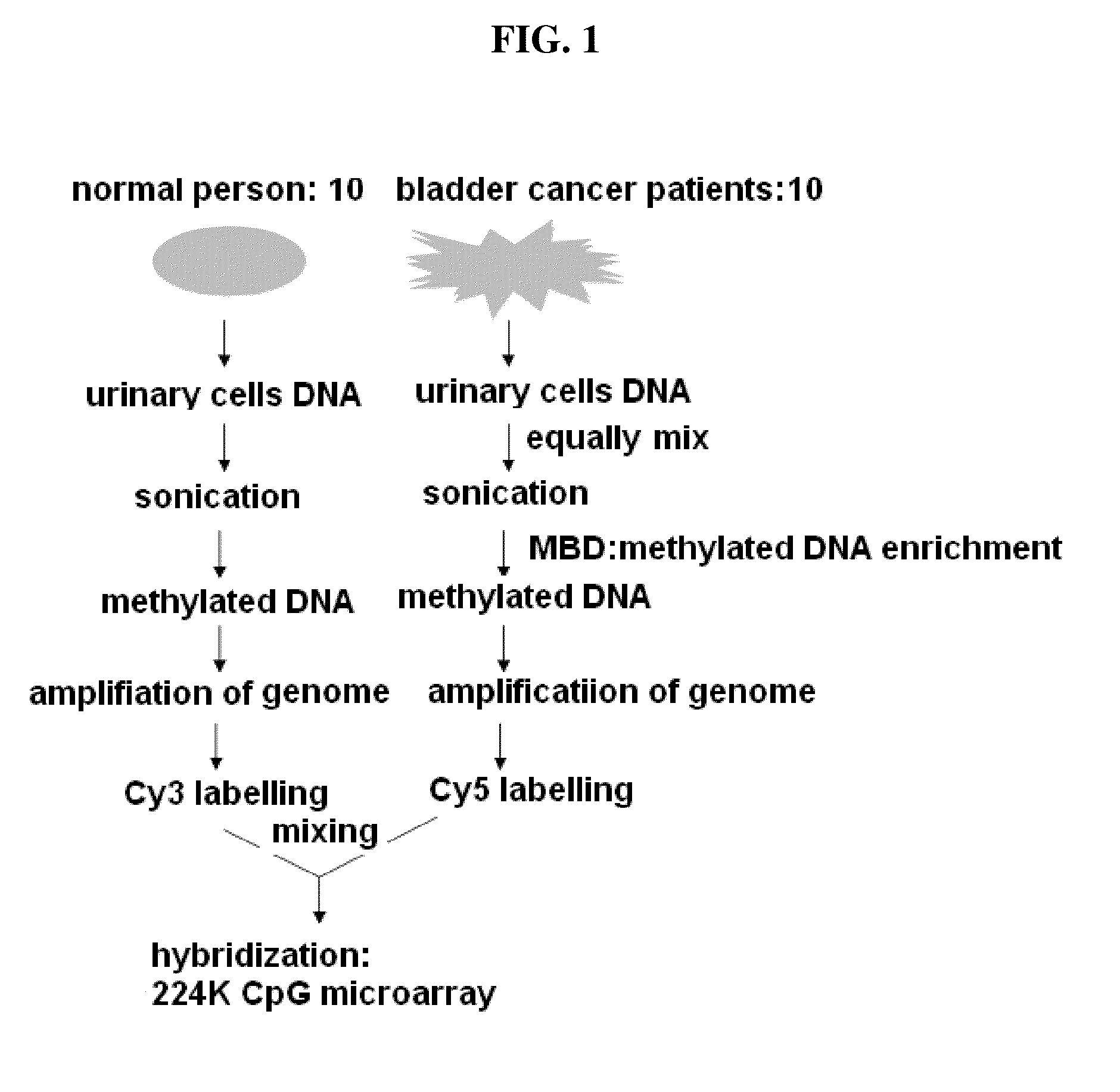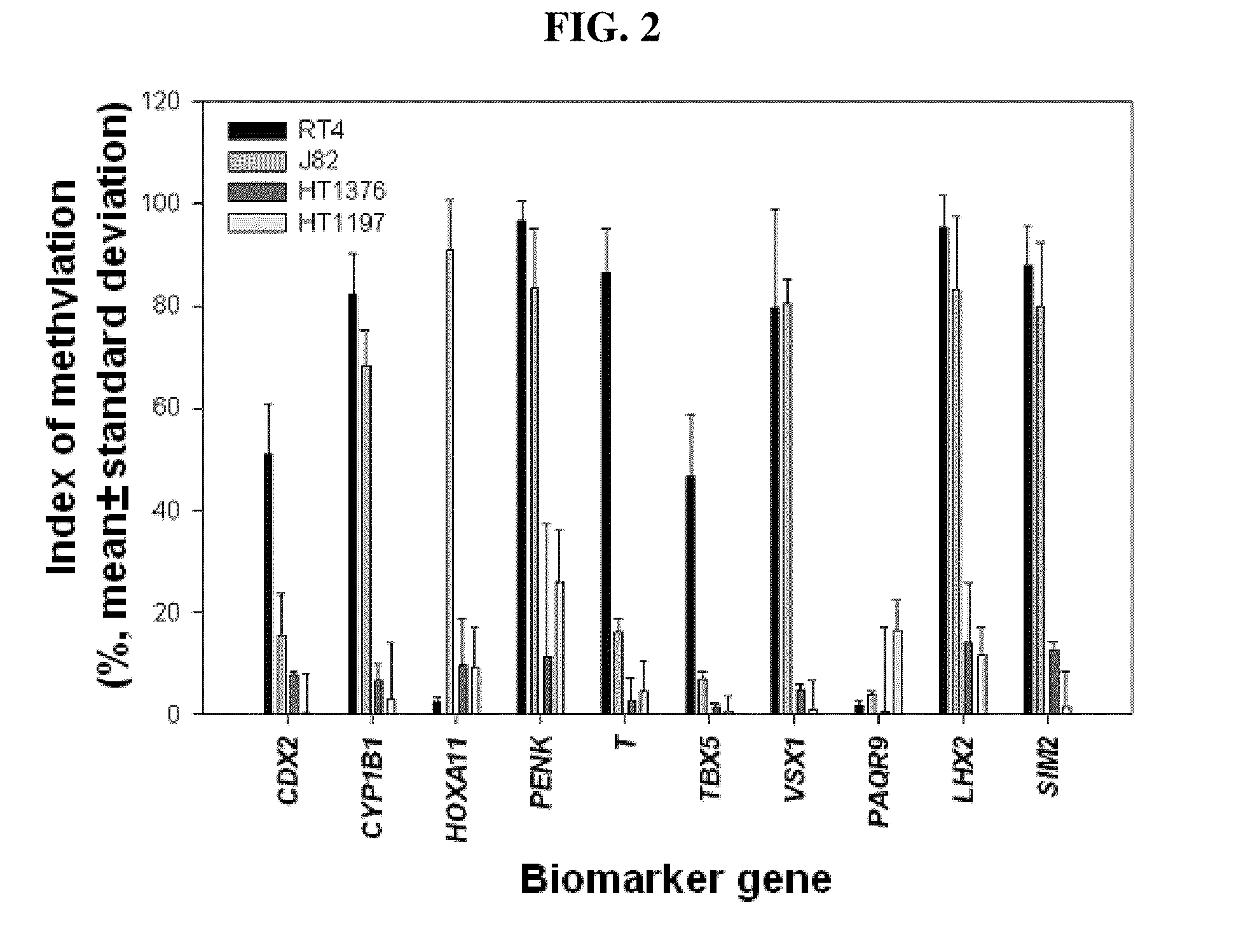Diagnosis kit and chip for bladder cancer using bladder cancer specific methylation marker gene
a bladder cancer and gene technology, applied in the field of bladder cancer diagnostic kits and nucleic acid chips, can solve the problems of low accuracy of method of finding abnormal cells in urine, difficulty in diagnosing bladder cancer at an early stage, and low accuracy
- Summary
- Abstract
- Description
- Claims
- Application Information
AI Technical Summary
Problems solved by technology
Method used
Image
Examples
example 1
Discovery of Bladder Cancer-Specific Methylated Genes
[0104]In order to screen biomarkers which are methylated specifically in bladder cancer, about 20 ml of the urine of each of 10 bladder cancer patients and 10 normal persons was centrifuged in a centrifuge (Hanil Science Industrial Co., Ltd., Korea) at 4,200×g for 10 minutes to isolate urinary cells. The supernatant was discarded, and the cell precipitate was washed twice with 5 ml of PBS. Genomic DNA was isolated from the cell precipitate using the QIAamp DNA Mini kit (QIAGEN, USA). 500 ng of the isolated genomic DNA was sonicated (Vibra Cell, SONICS), thus constructing about 200-300-bp-genomic DNA fragments.
[0105]To obtain only methylated DNA from the genomic DNA, a methyl binding domain (MBD) known to bind to methylated DNA (Fraga et al., Nucleic Acid Res., 31:1765-1774, 2003) was used. Specifically, 2 μg of 6× His-tagged MBD was pre-incubated with 500 ng of the genomic DNA of E. coli JM110 (No. 2638, Biological Resource Center...
example 2
Measurement of Methylation of Biomarker Genes in Cancer Cell Lines
[0110]In order to further determine the methylation status of the 10 genes, bisulfite sequencing for each promoter was performed.
[0111]In order to modify unmethylated cytosine to uracil using bisulfite, total genomic DNA was isolated from the bladder cancer cell lines RT-4 (Korean Cell Line Bank (KCLB 30002), J82 (KCLB 30001), HT1197 (KCLB 21473) and HT1376 (KCLB 21472), and 200 ng of the genomic DNA was treated with bisulfite using the EZ DNA methylation-gold kit (Zymo Research, USA). When DNA is treated with bisulfite, unmethylated cytosine is modified to uracil, and the methylated cytosine remains without changes. The DNA treated with bisulfite was eluted in 20 μl of sterile distilled water and subjected to pyrosequencing.
[0112]PCR and sequencing primers for performing pyrosequencing for the 10 genes were designed using the PSQ assay design program (Biotage, USA). The PCR and sequencing primers for measuring the me...
example 3
Measurement of Methylation of Biomarker Genes in Urinary Cells of Bladder Cancer Patients
[0116]In order to verify whether the 10 genes can be used as biomarkers for diagnosis of bladder cancer, about 20 ml of the urine of each of 20 normal persons and 19 bladder cancer patients was centrifuged in a centrifuge (Hanil Science Industrial Co., Ltd., Korea) at 4,200×g for 10 minutes to isolate cells. The supernatant was discarded, and the cell precipitate was washed twice with 5 ml of PBS. Genomic DNA was isolated from the washed cells using the QIAamp DNA Mini kit (QIAGEN, USA), and 200 ng of the isolated genomic DNA was treated with bisulfite using the EZ DNA methylation-Gold kit (Zymo Research, USA). Then, the DNA was eluted in 20 μl of sterile distilled water and subjected to pyrosequencing.
[0117]20 ng of the genomic DNA converted with bisulfite was amplified by PCR. In the PCR amplification, a PCR reaction solution (20 ng of the genomic DNA modified with bisulfite, 5 μl of 10×PCR bu...
PUM
| Property | Measurement | Unit |
|---|---|---|
| temperature | aaaaa | aaaaa |
| temperature | aaaaa | aaaaa |
| frequency | aaaaa | aaaaa |
Abstract
Description
Claims
Application Information
 Login to View More
Login to View More - R&D
- Intellectual Property
- Life Sciences
- Materials
- Tech Scout
- Unparalleled Data Quality
- Higher Quality Content
- 60% Fewer Hallucinations
Browse by: Latest US Patents, China's latest patents, Technical Efficacy Thesaurus, Application Domain, Technology Topic, Popular Technical Reports.
© 2025 PatSnap. All rights reserved.Legal|Privacy policy|Modern Slavery Act Transparency Statement|Sitemap|About US| Contact US: help@patsnap.com



